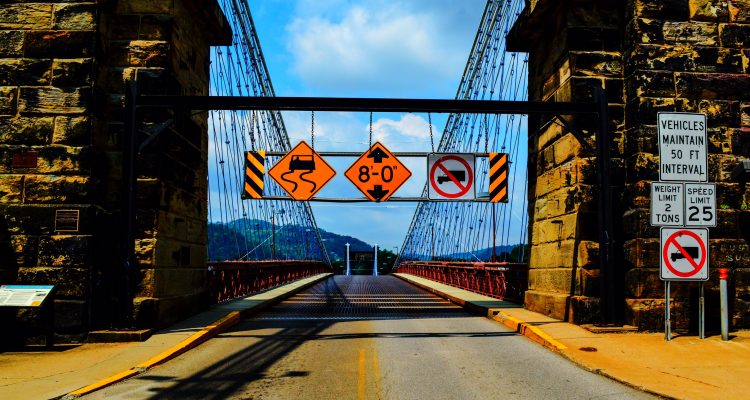I sat on the sidewalk Wednesday morning near the downtown Wheeling end of the historic Suspension Bridge with a pen and a notebook in my hands, and I counted cars and vans and trucks that were either exiting or entering the 166-year-old span.
THE MISSION: Count the first 100 vehicles in an effort to examine the percentage of motorists who were operating machines that weighed more than the bridge’s weight limit of 2 tons, or 4,000 pounds. I jotted down each one at a pace much more hurried than I initially anticipated, and then later in the day I returned to the Internet to continue the research.
Ford Fusion. Cadillac Escalade. Chevrolet Tahoe. Toyota Camry. Ford F-150. Mercedes Benz GL350. Nissan Altima. Honda CR-V. BMW 760i. Jeep Cherokee. Dodge Durango. Oldsmobile Cutlass Cierra. Kia Sorento. Range Rover. Honda Civic. Subaru WRX Wagon. Volkswagon Beetle. Acura TSX. Chrysler Town & Country.
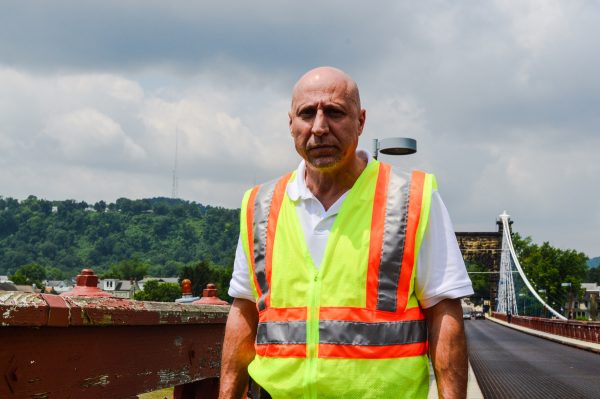
And there were many more makes and models in the 21 minutes it took me to count to 100 during this 11 a.m. hour. Fifty-three of the vehicles displayed Ohio license plates on their fronts and rears, and the other 47 included tags from West Virginia, Arkansas, Louisiana, and Pennsylvania.
Those “real” facts I can share. What I cannot be exact about are the years in which these vehicles were introduced because these cars, crossovers, light-duty trucks, SUVS, vans, and minivans did not display that information. However, according to websites such as Consumer Report, Motor Trend, and Autos.com – and according to my eyewitness-guestimations – 68 of the 100 I counted weighed in heavier than the Suspension Bridge’s 4,000-pound weight limit without the driver, passengers, and cargo.
If we add those pounds into the equation, we must consider the following facts from the federal Center of Disease Control. According to the CDC (http://www.cdc.gov/nchs/fastats/body-measurements.htm), the average adult male weighs in at 195 pounds, and the average adult female weighs 166 pounds.
Black-and-white signs are posted on the right side of both entrance lanes of the Suspension Bridge’s east and west on-ramps: “WEIGHT LIMIT 2 TONS.”
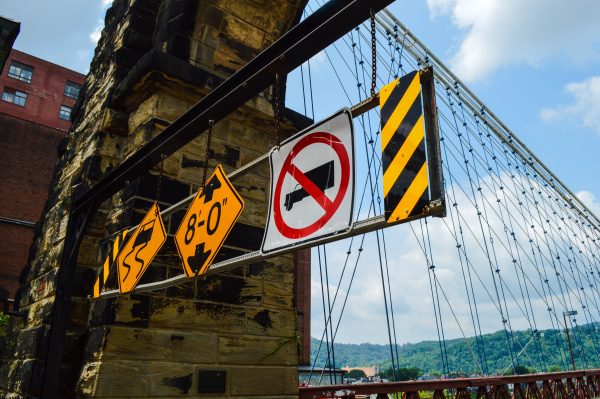
And 2 Tons Equals 4,000 Pounds.
“Unfortunately, it is a matter of enforcement and a matter of awareness,” said Gus Suwaid, district engineer for DOH District 6. “The weight limit is based on how the bridge was designed and what it can hold. Compliance? That’s the enforcement part of the problem.
“People just need to pay attention to the weight limit because the bridge has great historic value, and we want to safeguard it for that very reason,” he continued. “That takes the public’s cooperation and participation, but we’re not seeing a lot of that.”
The fact that the vehicles crossing the Wheeling Suspension Bridge are mostly more than 2 tons is actually old news examined by the New York Times more than a decade ago. On May 5 of that year, writer Danny Hakim reported: “The average new car or light-duty truck sold in the 2003 model year tipped the scales at 4,021 pounds, breaking the two-ton barrier for the first time since the mid-1970’s, according to a report released by the Environmental Protection Agency last week.”
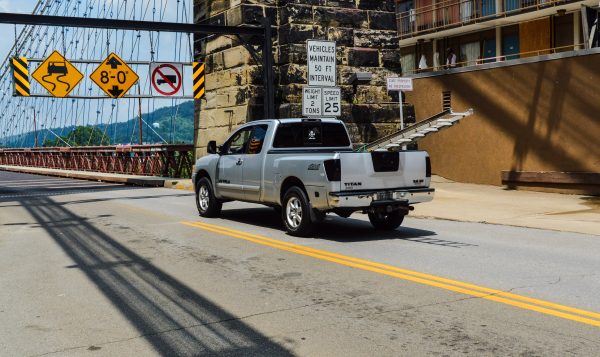
The Wheeling Suspension Bridge represents still-standing history that remains in a local way just as vital a roadway as it was when first opened in 1849. Charles Ellet Jr. designed this bridge, and because it was the first span to allow a gateway to West over the Ohio River, its significance reaches far beyond the borders of the Friendly City.
It measures 1,010 feet from tower to tower, and it was first recognized as a National Historic Landmark in 1975; it was the world’s longest suspension bridge between 1849-1851, and it remains the oldest vehicular suspension bridge still in use in the United States.
Not only is there a 2-ton limit, but a 50-foot interval rule is also in effect for motorists crossing the span, and not only are there a black-and-white signs, but also white lines have been painted along the inside of the lanes of the bridge. That rule, too, is often ignored.

“The whole purpose of that interval rule is weight and stress distribution, according to the weight limit,” Suwaid said. “It’s about balance, and that’s because of the way this suspension bridge was designed. There are the towers on both sides but nothing in the middle because in the mid-1840s those people had no idea to have to build the supports in the middle of the river.”
Still, nearly no one seems to care.
“Although I am not a structural engineer, what I can tell you is that with the public’s participation we will be able to preserve it for a long time. Without that cooperation, it will be more of struggle,” Suwaid said. “As long as people start to comply with the posted regulatory signs, we’ll be OK.
“I think what we need to remember is that this bridge was designed and constructed before the automobile was even invented. The fact that it handles the weight that it does now should be a testament to how well built it is,” he continued. “But 2 tons is 2 tons, and today’s vehicles weigh what they weigh these days. Most people probably do not realize how much their vehicles weigh.”
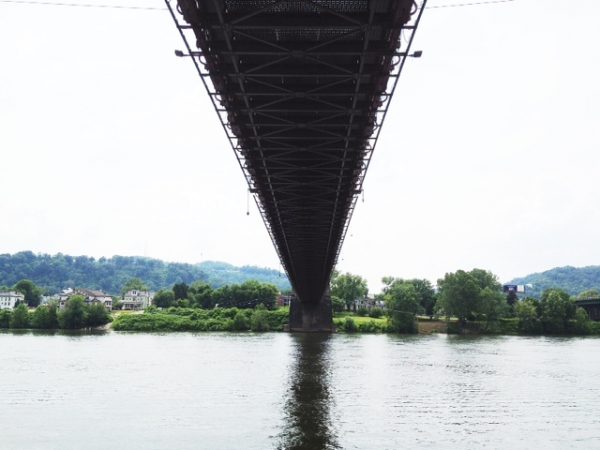
The enforcement, though, does not fall into the hands of officials of the state Division of Highways. Enforcement would be the job for members of the Wheeling Police Department, and when those law enforcement officers are protecting and serving the citizens of Wheeling, they are doing so while driving cruisers and SUVs that mostly surpass the bridge’s weight limit.
“None of our big trucks should ever go across it even if they can access it below the signage,” said Robert Herron, Wheeling’s city manager. “Our ambulances don’t go across it, and our dump trucks don’t go across it.
“The police department does not have an exemption, but it’s not in the public’s best interest to not allow the police vehicles to go over that bridge,” he continued. “But as far as the larger vehicles are concerned, the people operating those vehicles know that they are not permitted to travel across the Wheeling Suspension Bridge.”

Herron said the city is currently investigating ways to further protect people in the Heritage Port area, and one option is camera placement. The city’s CEO added that the city may include the historic span in the process.
“That would be the time to do the same on the bridge if we can figure out the best location for it,” Herron said. “It would be a deterrent because the police would be watching, and in some cases I’m sure the violators could be found and prosecuted the way they should be.”
Suwaid has contacted the state’s Public Service Commission because the agency can supply a presence at the Wheeling Suspension Bridge. When in place, the crews will deploy portable scales to weigh vehicles that could be in violation.
“It is my understanding that they will be showing a presence here in the future,” the district engineer said. “It’s an issue that needs to be addressed because the rules are being ignored. It’s obvious, and I see it every time I am at the bridge.”
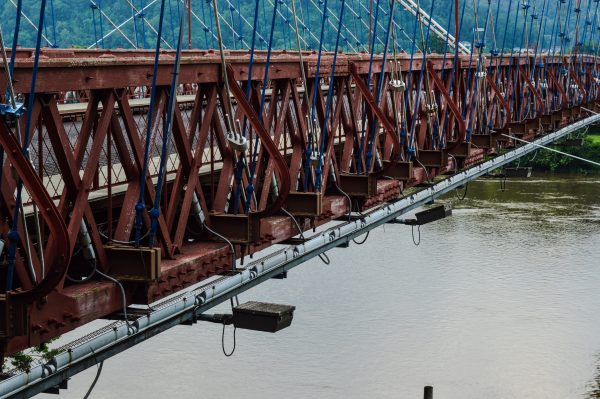
The Impending Closure
Traveling over the Wheeling Suspension Bridge is still fun for me because of the history, and because of the “bbrrruummmm” that vibrates along the frame of the vehicle crossing the Ohio River’s front channel. It’s different, so it’s special.
Walking over the span is a completely different experience for anyone even a little afraid of heights, and that’s because it is see-though and nothing but the deep, quickly flowing Ohio River is quite visible below. Perhaps it would make a difference if there weren’t a history of collapse, but that history exists. It was during a windstorm on May 17, 1854, when the bridge deck was twirled as high as the eastside tower before collapsing into the river. Ellet rebuilt it, and the span has been fortified since. Ellet’s original design was for a 16-foot-wide travel deck, but in 1956 the state chose to diminish the walkway areas to add four feet in roadway width.
It still sways; it jumps and drops; it vibrates; there’s no handrail between the bridge decks and the walkways on both sides; and the bridge’s banister is no longer suitable as a support because of the badly chipped paint. It could actually cut you.
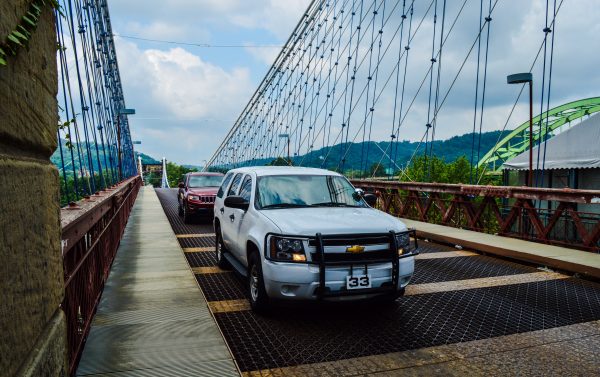
“It needs fixed,” Herron said. “The Wheeling Suspension Bridge is not only an iconic and historical symbol for the city of Wheeling but also for the entire state of West Virginia. Its significance is right up there in the 1 percent of historic places in the entire country.
“Not only that, but it’s also functional, and a lot of people rely on the Suspension Bridge every single day,” he said. “But it is old, and the Division of Highways is developing a project to completely rehabilitate it, and I believe that project will happen. We would rather see it sooner than later, but it is in the pipeline, and I believe within the next year or so that project will hopefully start.”
BUT – and that’s purposely a BIG but because of the project delays during the past three years.
But if the 2016 project schedule does not change for DOH District 6 officials, yet again the Wheeling Suspension Bridge will close to vehicular and pedestrian traffic in late-September of the next year to clear the way for an $8 million renovation/preservation project.

And it will be closed for two years.
“We don’t know the full details for the design for the Wheeling Suspension Bridge, but I can tell you that the bulk of the project will address the electric and lighting of the bridge,” said Suwaid. “The focus of this project is a preservation one, and it will entail addressing any kind of deficiency that we find along the way.
“The bridge will also be painted, and the cables will be thoroughly examined, and any kind of rust that we find will be addressed in the proper way,” he continued. “The Suspension Bridge has been completely inspected, and we know what we need to do so as soon as the design is complete, we will prepare to get this project started next year.”
At the time the preservation project was first announced in 2011, the projected cost was $650,000 and involved the painting of the span along with replacing light bulbs and damaged fixtures. That was, though, before the “hard look” took place, and from that point many zeros were added to final price tag.

But the public’s voice via their vote also is a factor.
“The decision was made to address the lighting and electrical system on the bridge, and that’s why the cost of the project increased to the extent that it has,” Suwaid said. “We are working now on multiple scenarios and schemes for the lighting system.
“The options will be presented to the state’s historic preservation office, and they will also be introduced to the public for approval,” he revealed. “The lighting system will be computer-based so that the different schemes will be available for use after it is introduced to the public to vote on.”
The Suspension Bridge has been closed on four occasions in the past four years, twice because of snapped sway cables, and twice more because of vehicular accidents. It is safe, and hundreds of crossers prove it every single day, but it needs some love.
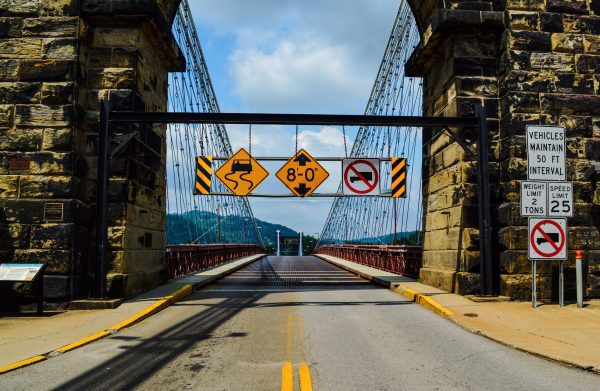
“The cables that failed were not weight-bearing cables, but they were cables that work to keep the bridge as straight as it is supposed to be as traffic flows over it,” Suwaid said. “When problems like the ones we have experienced take place, it usually has a lot to do with the freeze and the thaw that we have in this region of the country.
“The Suspension Bridge is monitored very closely because of what it represents about the history of this area and because of how important it is to the residents of Wheeling,” he added. “That’s why there have been the delays. The intention is to preserve this piece of history for as long as possible. But the public can help.”
(Photos by Steve Novotney)


